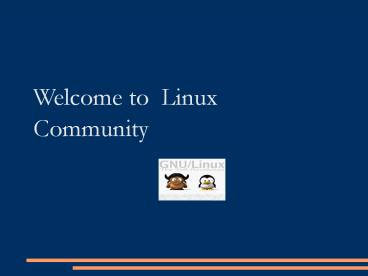Welcome to Linux Community - PowerPoint PPT Presentation
Title:
Welcome to Linux Community
Description:
Multics, AT&T Bell Lab, GE, MIT. 1969, UNIX, Ken ... SunOS, Solaris, HP-UX, AIX, SCO UNIX. A Short History of UNIX. A Short ... SuSe,Ubuntu, Gentoo ... – PowerPoint PPT presentation
Number of Views:87
Avg rating:3.0/5.0
Title: Welcome to Linux Community
1
Welcome to Linux Community
2
What is GNU/Linux?
- A free Unix-type operating system developed under
the GNU General Public License. - Open source
- Popular
- Support most of the platforms available
3
A Short History of UNIX
- Multics, ATT Bell Lab, GE, MIT
- 1969, UNIX, Ken Thompson, Dennis Ritchie
- 1973, Rewrite UNIX with C
- Berkeley UNIX(BSD UNIX)
- Commercial products
- SunOS, Solaris, HP-UX, AIX, SCO UNIX
4
A Short History of Linux
5
A Short History of Linux(2)
6
Is Linux difficult ? This may be true. But the
real question is do you really want to learn it?
7
- What are the benefits of Linux?
- Linux can give you
- A modern, very stable, multi-user, multitasking
environment. - Advanced graphical user interface. Linux uses a
standard, network-transparent X-windowing system
with a "window manager" (typically KDE or GNOME
but several are available). - The graphical desktop under Linux can be made to
look like MS Windows (or probably ANY other
graphical user interface of your choice).
8
Dozens of excellent, free, general-interest
desktop applications. These include a range of
web browsers, email programs, word processors,
spreadsheets, bitmap and vector graphics editing
programs, file managers, audio players, CD
writers, some good games, typing tutor,
etc. Freedom from viruses. Linux has no viruses
because it is too secure an operating system for
the viruses to spread with any degree of
efficiency.
9
Linux is quite positively here-to-stay because of
its open-source nature (Linux cannot possibly be
put out-of-business). It is a standard selected
for countless projects that are not going to go
away, and some of them are quite
"mission-critical." Try the International Space
Station, for which Linux is the operating system
(http//www2.linuxjournal.com/lj-issues/issue59/30
24.html).
10
- In a nutshell, the GNU General Public Licence
(GPL) allows anybody to - use the software at no charge, without any
limitations, - copy, and distribute or sell unmodified copies of
the software in the source or binary form, - use the software with propriatory (e.g., your
own) modifications, free of charge, as long as
you do not distribute or sell the modified
version, - modify, and distribute or sell a modified version
of the software as long as the source code is
included and licenced on the same terms as the
original you received (the GPL), - sell support for the software, without any
limitations.
11
What the GPL license does not allow code
recipients to do is to take somebody elses
software licenced under GPL, modify the software,
and then distrubute a this modified version of
the software under a propriatory licence.
Speaking plainly, the GPL licence just forbids
stealing existing (somebody else's) software for
incorporation into a closed, commercial-only
product.
12
I need warranty and security. With commercial
software, I can sue if things go wrong.
Things go wrong on many MS Windows NT machines
every day, and there are no damages awarded by
courts. Read your MS Windows license agreement to
find out that there is no guarantee whatsoever
that ANYTHING will work. Trying to sue would be a
waste of your money.
13
Linux Distros
- A Linux distribution, often simply distribution
or distro, is a member of the Linux family of
Unix-like computer operating systems. - Distros mainly based on Look and Feel and
Applications
- Distros
- Red Hat Fedora, Debain, SuSe,Ubuntu, Gentoo
14
File System
- Windows uses letters of the alphabet to represent
different devices and different hard disk
partitions. Under Windows, you need to know what
volume (C, D,...) a file resides on to select
it, the file's physical location is part of it's
name. - In Linux all directories are attached to the root
directory, which is identified by a
forward-slash, "/". - root. - For example, below are some second-level
directories
15
- /bin System binaries, including the command
shell - /boot Boot-up routines
- /dev Device files for all your peripherals
- /etc System configuration files
- /home User directories
- /lib Shared libraries and modules
- /lostfound Lost-cluster files, recovered from a
disk-check - /mnt Mounted file-systems
- /opt Optional software
- /proc Kernel-processes pseudo file-system
- /root Administrators home directory
- /sbin System administration binaries
- /usr User-oriented software
- /var Various other files mail, spooling and
logging
16
Linux Help
- man
- info
- command help
- Forums.
17
man command
- The -k option
- man k print
- Manual pages are divided in 8 sections
- User commands
- System calls
- Libc calls
- Devices
- File formats and protocols
- Games
- Conventions, macro packages and so forth
- System administation
- To select correct section, add section number
- man 1 passwd, man 5 passwd
18
info command
- A program for reading documentation, sometimes a
replacement for manual pages - Example info ls
19
Links http//en.wikipedia.org/wiki/Unixhttp//
en.wikipedia.org/wiki/LinuxDownload Source Code
from http//www.kernel.orgBooks Unix User
Guide Rebecca Thomas Your UNIX The Ultimate
Guide-Sumitabha Das
20
Thank you































